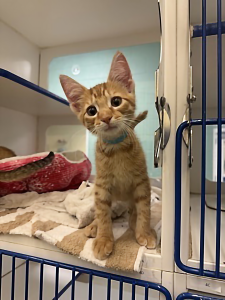A New Leash on Life
Discover the joy of rescue pets

I call myself an “accidental cat mom.”
The summer before my junior year of college, right after I’d signed the lease on my first apartment, I got a call from my dad. He’d just rescued a four-week-old kitten that fell down an old, blocked chimney after chiseling out bricks until he could reach in and grab the little guy. Busy with work and allergic to cats, my dad brought the kitten to me to “take care of him” — get him checked out at the vet and pass him off to a loving home.

As soon as I held that tiny ball of soot-covered fur and gazed into his baby-blue eyes, I was in love. My new apartment would have a feline roommate.
Not everyone has the opportunity to rescue a pet quite so literally. If the “cat distribution system” (as dubbed by the internet) hasn’t found you yet, you’re in luck. Our area has several shelters and rescue centers full of pets ready to find their “fur-ever” homes.
To celebrate the universal birthday for shelter dogs, August 1st (aka DOGust 1st), we’re encouraging you to welcome a rescue pet into your home. Here’s what you need to know before adopting or fostering a pet.
Why Adopt?

So why choose to adopt your furry friend? First, it saves lives. “Every year, millions of pets enter shelters, and many face the threat of euthanasia simply because there aren’t enough adopters,” said Erin Johnston of the Brandywine Valley SPCA, a no-kill shelter with locations in West Chester, Delaware and beyond. “When you adopt, you give an animal a second chance at life. You also create space at the shelter for another pet looking for their second chance.”
In addition, adoption allows you to get to know your pet before bringing them home. Shelter staff spend a lot of time with the animals in their care, so they can help you choose the right pet for your family and lifestyle. Most shelters and rescue organizations require a meet-and-greet before finalizing adoption, ensuring the pet and new owner are a good match.
Plus, many shelter pets are adults, which tend to be calmer than their younger counterparts. And there’s the big bonus of skipping the chaotic puppy or kitten stage. While little critters are adorable, they require a lot more attention (and patience!). But don’t worry, our local shelters still have plenty of puppies and kittens if that’s your dream.
Finally, adopting a pet is typically less expensive than getting one from a breeder. Adoption fees vary but are typically around $200 to $500 for dogs and $100 to $150 for cats (more for puppies and kittens). Your adoption fee includes veterinary services like spaying or neutering, flea and tick treatments, vaccinations and microchipping. Plus, many pets have sponsored adoption fees, especially pets that are older, have been in the shelter for a long time or have special needs.
Preparing to Adopt

When deciding whether to add a new furry friend to your family, there’s plenty to consider. Remember, owning a pet is a major responsibility and a yearslong commitment.
“Choose a pet whose energy matches [your] lifestyle. Also, kids and other pets need to be a consideration,” said Lisa Maggio of Main Line Animal Rescue, a no-kill shelter in Phoenixville and affiliate of the Pennsylvania SCPA.
Also keep in mind the financial responsibility — adoption fees, supplies, food and ongoing vet care — and pets’ lifespan: “Dogs and cats often live 10 to 20 years; some birds and reptiles can live much longer,” Maggio said.
Finally, consider your housing situation. “Dogs may need a yard, while cats need more quiet, vertical spots,” said Maggio. If you rent, find out if your lease agreement has any size or breed restrictions.
It’s also important to choose a reputable shelter or rescue organization. Do your research here — talk to your veterinarian, family and friends, and check online reviews. Find out about what veterinary care the organization provides and what kind of support they offer after adoption.
“When choosing an organization to adopt from, you should find one in your community that aligns with your values,” Johnston said. “For example, Brandywine Valley SPCA shelters practice open adoption policies and don’t breed label [categorizing dogs by breed, which can lead to misconceptions] in an effort to break down barriers to adoption. We also have programs for senior adopters and military veterans, and many of our pets are sponsored by loving supporters of our organization.”
Adopting a Pet
Ready to adopt? Each organization has its own adoption process, but here are some things to expect.
First, check the shelter or rescue’s website to see all the animals available for adoption there. If one captures your heart, make a plan to meet them. Many shelters take walk-ins, while other rescue organizations may require an appointment. Bring the whole family to meet your potential new pet. If you’re adopting a dog, many organizations recommend or require a visit with any dogs already living in your home to see how they get along.

You’ll also need to fill out an adoption application, whether online or in person, and speak with an adoption representative. “During your visit, our dedicated staff and volunteers will work with you to help match a pet to your family’s interests, lifestyle and needs,” said Maggio.
If you’ve had pets before, you’ll likely need to provide vaccination records and potentially a reference from a veterinarian. Some organizations ask for personal references, and some require a fenced-in yard for dogs.
If you’re approved, congratulations! It’s time to take your new furry friend home. If you’re adopting a dog, bring a collar and leash with you. If you’re adopting a cat, bring a carrier. Also make sure your home is prepared for your new family member. You’ll need food, toys, a cozy bed, a crate for dogs, a litter box and scratcher for cats.
While a good shelter or rescue organization will provide veterinary care before adopting out a pet, it’s important to follow up with your own veterinarian, ideally within the first week. Finally, be patient with your new pet — it may take days or even weeks for them to adjust to their new home.
Consider Fostering

Before finding their forever home, many rescue pets need a place to stay and get special care. Maybe they’re recovering from illness or injury, are pregnant or nursing, too young to be adopted, or just need a little extra socialization before they’re ready for that next step. That’s where foster families come in — volunteers who welcome pets into their homes until they can be adopted.
“There are many good reasons for people to consider fostering animals,” said Lauren Smith of All 4 Paws Rescue, a foster-based rescue in Malvern. Unlike a traditional shelter, all their rescue pets are housed in foster homes before adoption. “First, we’re in the middle of a crisis with the huge number of homeless animals. Shelters and rescues are constantly getting calls to save dogs and cats that have been abandoned or are being surrendered. The number of homeless animals far exceeds the foster homes available for them. When homeless animals go to foster homes instead of shelters, they’re much happier, relaxed and prepared for adoption. In sum, fostering saves lives.”
Fostering is a great option for people who love animals but aren’t ready or able to commit to the lifelong care of a pet. It’s also less of a financial commitment than adoption — most organizations pay for foster pets’ veterinary care, and some even pay for food and other expenses, too. And, if you fall in love with a foster pet, you may have the option to adopt them yourself — what folks in the biz call a “foster fail.”
“Before fostering, people should be aware of the process of the shelter or rescue for fostering and adopting the animals,” Smith said. “People should be sure they’re willing to make a commitment to that animal — health, safety, etc. — until the animal is adopted. Animals that have been rescued need consistency and stability. Fostering is rewarding, but it’s a commitment.”
A Final Note
As we covered in our August 2024 issue, lots of folks in our area are choosing nontraditional pets. Even if you choose a not-so-common pet, you can still adopt.
While most rescue organizations focus on cats and dogs, some care for farm animals and other unusual critters. Glenmoore Farm Animal Rescue in West Grove, for instance, has rescued horses, donkeys, pigs, chickens and even a peacock!
Welcoming a rescue pet into your home is a life-changing and incredibly rewarding decision. Not only are you giving an animal a second chance at love and safety, but you’re gaining a loyal companion that will bring you joy, purpose and connection.
Whether you’re ready to make a lifelong commitment or simply have room in your heart and home to help for a while, adopting and fostering are meaningful ways to make a lasting difference.
After all, what’s life without wagging tails, wet noses and cozy cuddles from a furry friend?
Adopt Me!
 Meet Arianna! She’s a 1-year-old lady with a gorgeous, silky coat. Arianna has been coming out of her shell more and more with each day and doesn’t mind being handled or petted. Staff and volunteers look forward to watching her grow in confidence and find her purr-fect match! Meet her at the Brandywine Valley SPCA’s West Chester campus.
Meet Arianna! She’s a 1-year-old lady with a gorgeous, silky coat. Arianna has been coming out of her shell more and more with each day and doesn’t mind being handled or petted. Staff and volunteers look forward to watching her grow in confidence and find her purr-fect match! Meet her at the Brandywine Valley SPCA’s West Chester campus.
Note: Arianna is available for adoption at press time. There are plenty more lovable cats and dogs in need of a home!
